Facing institutional racism as well as the enemy, African-Americans have fought throughout our nation's history with honor and bravery, often making the ultimate sacrifice in service to their country. Here are just a few of their stories.
54th Massachusetts Infantry Regiment
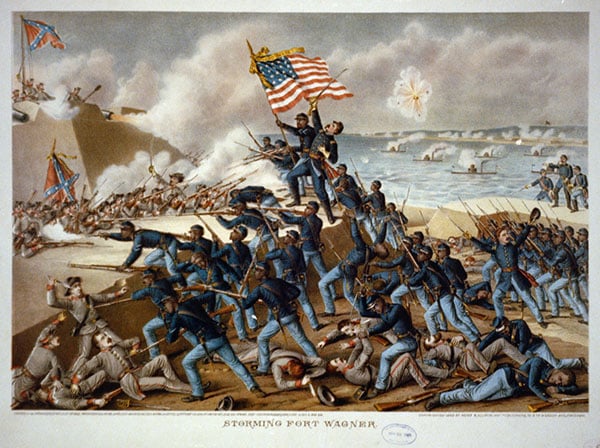
It is estimated around 179,000 African-Americans served in the U.S. Army during the Civil War, and another 19,000 served in the Navy. Perhaps the best-remembered African-American regiment of that era is the 54th Massachusetts Infantry, which comprised 1,007 black soldiers led by a white colonel named Robert Gould Shaw.
The 54th Massachusetts fought well, demonstrating valor and bravery over several battles in South Carolina, Georgia, and Florida. But there were horrific losses, too. On July 18, 1863, just four months after the regiment was formed, Shaw amassed 600 soldiers for an assault on Fort Wagner, S.C., which guarded the Port of Charleston. Unfortunately, Union intelligence regarding the fort was faulty, and an overwhelming force of 1,700 well-armed Confederate soldiers awaited them. The result was a massacre. More than a third of Shaw's forces were killed, wounded, or captured, and Shaw, who led the charge, was among the first to die. Though the assault was a failure, the 54th managed to inflict heavy damage and the fort was abandoned shortly after.
On Memorial Day 1897, a statue by Augustus Saint-Gaudens commemorating the 54th Massachusetts Infantry was unveiled on the Boston Common. The regiment also was the subject of the 1989 movie Glory, starring Denzel Washington.
369th U.S. Infantry Regiment
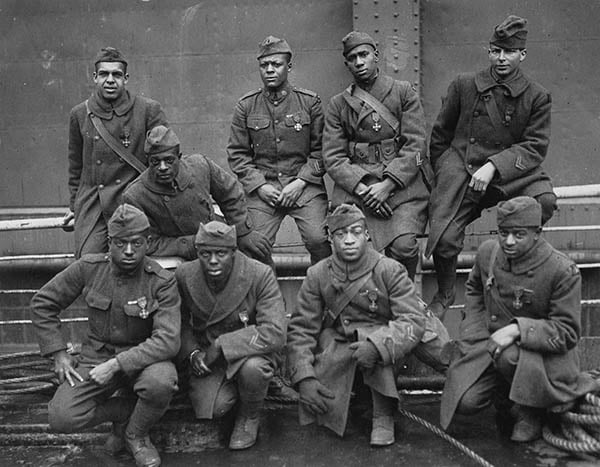
Sometimes referred to as “Pershing's orphan soldiers,” the predominantly black 369th U.S. Infantry Regiment broke the color barrier as the first African-American soldiers to man the front lines at the height of World War I. However, they had to join the French Army to do it.
Gen. John Pershing attached the 360th to the 16th Division of the French 4th Army because he didn't want them fighting alongside white American soldiers. The war-weary French, however, greeted the 369th with open arms. As part of the French 4th, the 369th saw a total 191 days of combat, fighting so bravely their French comrades nicknamed them Harlem's Hellfighters.
Indicative of their valor on the battlefield was an incident involving Pvt. Henry Johnson and Pvt. Needham Roberts, who were manning a listening post in no-man's land on the Western Front when they were attacked by 24 German soldiers on a nighttime snatch-and-grab mission. Both men were shot, Johnson three times. But he quickly rose and fired his three-shot rifle, killing as many enemy soldiers. He used the empty rifle as a club until it shattered, then grabbed his bolo knife and savagely slashed at every German soldier within arm's reach. Unable to capture the feisty redcap from Albany, the remaining German soldiers finally retreated but not before Johnson used his grenades to kill several more. For his bravery, Johnson was awarded the Croix de Guerre by the French military. Later, the entire regiment was awarded the same. In June 2015, Johnson posthumously was awarded the Medal of Honor (read more in “Selfless Courage”).
“The Hellfighters were pioneers,” observes Stephen Harris, author of Harlem's Hell Fighters: The African American 369th Infantry in World War I. “They paved the way for other black regiments and proved they could fight. It's a legacy that continues today.”
Read more about the Hellfighters in the February 2014 issue of Military Officer.
320th Barrage Balloon Battalion
Photo Credit: Army Signal Corps file photo
On the morning of June 6, 1944, Allied forces stormed the beaches at Normandy, France, in an effort to finally bring the ground war to Germany. It was a day of tremendous peril, and in the thick of it was the 320th Barrage Balloon Battalion, the only African-American combat unit to take part in the D-Day invasion.
Barrage balloons were huge, unmanned inflatables anchored to the ground with steel cables. Their job was to provide protection from low-flying enemy planes, either by snagging them with cables or forcing the planes to fly at higher altitudes.
The 320th came ashore with the infantry early on the morning of June 6, and its medics immediately started treating the hundreds of casualties that lined the beach. One medic named Waverly Woodson worked almost nonstop for 30 hours despite being wounded himself, finally collapsing from exhaustion.
Once the beachheads were secure, the men of the 320th deployed their barrage balloons along the length of the Normandy coast, providing landing craft effective protection from German attack planes. “[The balloons] confounded skeptics by their part in keeping enemy raiders above effective strafing altitude,” reported Stars and Stripes.
Four members of the 320th perished during the Normandy invasion, but the battalion got the job done. In a commendation to the 320th, Gen. Dwight D. Eisenhower wrote, “Despite the losses sustained, the battalion carried out its mission with courage and determination and proved an important element to the air defense team.”
The Tuskegee Airmen
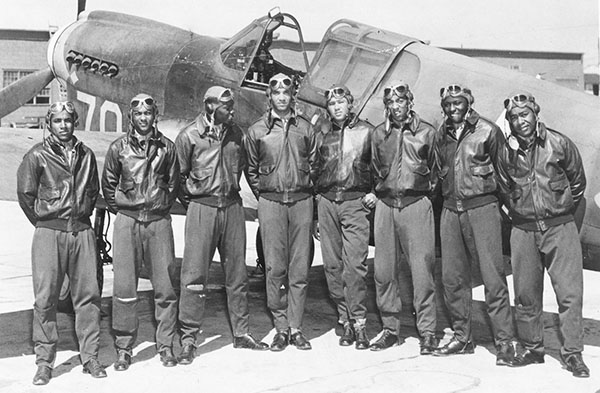
Perhaps the best-known group of African-Americans to serve during World War II is the Tuskegee Airmen, which included pilots, navigators, ground crews, and others and provided fighter support in North Africa, Sicily, and the mainland of Italy.
The 99th Fighter Squadron, which later joined the 332nd Fighter Group, was the first black American flying unit and the first of its kind to see combat. It deployed to North Africa in April 1943 and flew P-40s in defense of Allied shipping in the Mediterranean Sea, as well as missions against various enemy targets in Italy. Its valor earned the 99th two Distinguished Unit Citations before it became part of the 332nd.
In 1944, the Tuskegee Airmen found themselves escorting heavy bombers on raids deep into enemy territory for the 15th Air Force. Their planes - P-47s and, later, P-51 Mustang long-range fighters - had red tails for group identification, which gave the squadron the nickname Red Tails.
A total of 992 black pilots trained in Tuskegee, Ala., between 1941-46, and 355 deployed overseas. The squadron proved adept at flying almost any plane given to them and equally effective at protecting the bombers in their charge, even shooting down a few much faster German jets. Over the course of their service, the Tuskegee Airmen flew 1,578 combat missions (1,267 for the 12th Air Force and 311 for the 15th Air Force) and 179 bomber escort missions. A total of 84 airmen lost their lives in combat or accidents, and 32 were held as prisoners of war.
The Tuskegee Airmen received numerous citations for their service, including at least one Silver Star, 96 Distinguished Flying Crosses, 14 Bronze Stars, 744 Air Medals, and eight Purple Hearts.
6888th Central Postal Directory Battalion
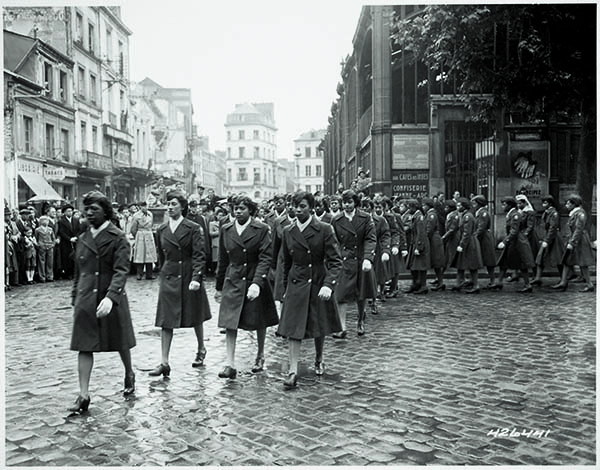
Credit: National Archives and Records Administration
As American forces spread rapidly across Europe following the Normandy invasion, the distribution of mail from home began to falter. By early 1945, warehouses in England and France were overflowing with undelivered letters and packages. It was the mission of the all-black, all-female 6888th Central Postal Directory Battalion to sort through the mountains of mail and make sure it was properly delivered. One general predicted the task would take at least six months; the unit did it in three.
Led by Maj. Charity Adams Earley, the 6888th comprised 824 African-American enlisted personnel and 31 officers drawn from the Women's Army Corps, the Army Service Forces, and the Army Air Forces. Like most service personnel of color, they faced tremendous hardships while trying to accomplish their mission, including forced segregation from white female soldiers and inferior living conditions.
The women of the 6888th worked eight-hour shifts, 24 hours a day, seven days a week. Individual servicemembers were tracked using nearly 7 million information cards that included serial numbers so the sorters could distinguish between soldiers with the same name. They played detective, searching for clues in letters and packages that were improperly or insufficiently addressed. They also had the sad duty of returning mail addressed to servicemembers who had died.
According to Beth Ann Koelsch, curator of the Betty H. Carter Women Veterans Historical Project at UNC-Greensboro, the greatest legacy of the 6888th was the advancement of women of color within the U.S. military. “They were under an incredible spotlight and had to struggle against a lot of prejudice,” she says, “but by all accounts I have read, these women talk with great pride about their service.”
Read more about their story in “All-Black Female Battalion Made History.”
2nd Ranger Infantry Company (Airborne)
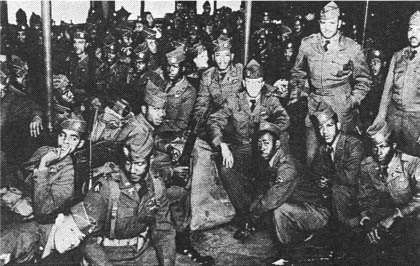
Attached to the 7th Infantry Division, the all-black 2nd Ranger Infantry Company was an elite Army unit that served in Korea between December 1950 and June 1951. Though not quite as well-remembered today as some other all-black military units, the 2nd Ranger Company played a significant role in demonstrating the dedication and courage of black servicemembers in combat and, ultimately, proving the value and importance of desegregation within the armed services.
After several weeks of training, the 2nd and 4th Ranger Companies reached Korea Dec. 29, 1950. The 2nd Rangers were attached to the 7th Infantry Division and experienced combat quickly. They participated in their first firefight Jan. 7, 1951, when 20 North Korean guerillas encountered a Ranger roadblock near the village of Changnim-ni. The unit also spearheaded an attack on the village of Majori-Ri and later aided a company trapped by the enemy, losing eight of their own in the process.
On March 23, the 2nd Ranger Company, attached to the 2nd Battalion, 187th Regimental Combat Team (Airborne), made military history by becoming the first African-Americans to make a parachute assault in combat - an airborne attack near Munsan-ni known as Operation Tomahawk. They successfully engaged the enemy several times over the next four days, with limited casualties.
The valor of the 2nd Rangers is confirmed by the number of merit citations the unit received: more than 100 Purple Hearts, nine Silver Stars, and 12 Bronze Stars for valor above and beyond the call of duty.
By: Don Vaughan



